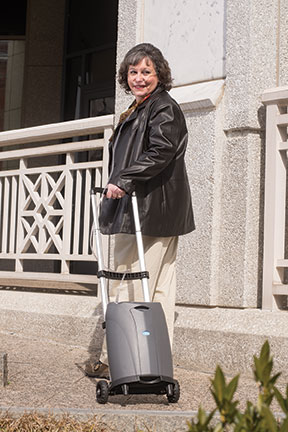
With the rise of heart disease, lung disease and COPD-related conditions, approximately 1.4 million people are using prescribed oxygen in the U.S. today and the number of new users is rising. Oxygen therapy enables many patients with COPD and other lung and heart diseases to live active lives for many years. Thus, more and more people are looking for ways to conveniently incorporate oxygen use into their everyday lifestyles. As a greater percentage of our populations seeks medical care due to aging and other issues, HME providers are in a prime position to provide reliable, profit-driven and clinically effective oxygen therapy to at-home oxygen users. Additional revenue streams are possible with oxygen accessories such as sleep therapy devices and masks.
Nondelivery: A Solution to Reimbursement Challenges
HME insiders such as Alicia Cafardi, senior manager of public relations at Philips Respironics, openly admit that competitive bidding has lowered Medicare reimbursement in many metro areas across the country. “We don’t see this trend reversing,” Cafardi says. “That said, the cost of goods is just one component of an HME’s overall operational cost structure. We think that there are more strategic approaches that will help HMEs navigate through the changing reimbursement environment.” According to Cafardi, HME providers should consider adopting different oxygen delivery models for different patient needs. For example, if a patient requiring multiple monthly deliveries is located more than 60 minutes from the office, the provider may consider alternative oxygen solutions, such as a Philips’s SimplyGo or UltraFill system, to minimize the operational expenses associated with deliveries. “There are also tools to evaluate business efficiency,” Cafardi suggests, “such as Philips Respironics’ Right Fit Oxygen Advisor, that can assist in guiding the HME to an appropriate solution.” “Reimbursement struggles will be with us for the foreseeable future,” agrees Bob Messenger, manager of respiratory education at Invacare Corporation, producer of the HomeFill Oxygen System, a versatile and durable nondelivery oxygen product that currently serves over 1.3 million patients. The HomeFill system allows patients to fill their own cylinders from their Invacare 5-liter and 10-liter concentrators. With this system, providers reduce costs by virtually eliminating cylinder deliveries, while patients enjoy an unlimited supply of ambulatory oxygen. “Given today’s reimbursement challenges Homefill, more than any other nondelivery oxygen product, uniquely positions providers to remain competitive and profitable in the oxygen space,” says Messenger. “Homefill fills the needs of more than 95 percent of the ambulatory market while not requiring the periodic replacement of expensive batteries.” The Homefill system appeals to oxygen users with more active lifestyles by allowing the patient to breathe at home from a continuous flow concentrator, and then use a convenient ambulatory pack when they are outside the home.
 The SeQual eQuinox offers verbal confirmation of changed flow rate settings.
The SeQual eQuinox offers verbal confirmation of changed flow rate settings.According to Brett Townsend, sales and marketing director at Chart Industries, HME providers can expect continued growth in the personal oxygen concentrator (POC) retail segment as patients are looking to purchase more modern solutions directly through HME providers and retail outlets. For customers seeking convenience and innovation, Chart Biomedical recently introduced the SeQual eQuinox, the lightest 3-liters-per-minute (lpm) POC on the market. “The SeQual is the first smart POC to give the patient voice feedback regarding flow rate, power status and any alarm conditions. “As in the SeQual eQuinox,” Townsend predicts, “we will continue to see smaller, lighter and more clinically robust POC development.”
Partnerships to Reduce COPD Readmissions
In today’s Affordable Care Act environment, HME providers also play a pivotal role in reducing hospital readmissions and the health care dollars spent on managing COPD. Following the relatively recent implementation of the 30-day hospital readmission program—where hospitals are penalized when patients return within 30 days for the same problem, or because of a complication from their previous stay, if the readmission is deemed by Medicare to be unnecessary—hospitals are beginning to realize the need for HME partners to help reduce readmissions through reliable oxygen products, excellent customer service and up-to-date oxygen education. “Manufacturers who can offer a range of products that address the full continuum of care will be allies to home care providers in identifying comfortable and efficient treatment that enables a patient to easily transition from hospital to home,” says Cafardi. As hospitals and patients increasingly rely on HME providers for at-home oxygen needs, those seeking long-term revenue growth should acknowledge the importance of service and quality, and stay on top of their customer’s feedback and ever-changing health needs. “This requires both a partnership mentality and a commitment to do just a little bit more than the guy down the street,” says Messenger. “Titrating conserving device settings and providing simple disease education are good first steps. Also, it’s about to become a data-driven world, and knowing your readmission rate will be an absolute necessity.” Messenger also maintains that 2015 will usher in an increasing demand for providers to demonstrate their ability to positively impact patient outcomes in the form of reduced COPD readmissions. “Oxygen technology is an important tool in achieving that goal,” he insists, “and providers will need to use clinical approaches to ensure not just oxygen delivery, but effective oxygen delivery.”
Smarter Oxygen Products
“We see more dealers looking to our product for 24/7 use,” says Rob Kent, president and CEO of O2 Concepts. “As we get more of a marketplace reputation for reliability, we are seeing more customers make the leap to using our product without a stationary concentrator.”
 The Freestyle 5 backpack is a convenient hands-free option.
The Freestyle 5 backpack is a convenient hands-free option.In fact, as oxygen users are looking for more convenience to suit their flexible and active lifestyles, many are looking well past bulky stationary concentrators. The O2 Concepts Oxlife Independence POC holds the characteristics of the industry’s most reliable stationary concentrators with the portability of a much less robust product. Offering an integrated cart that allows it to be the most agile and smallest product in its category, it also includes a user-friendly control panel to alleviate patient confusion. “To combat lower reimbursement rates, dealers are using our machine as a single solution, and billing both E1390 and E1392 codes,” says Kent. “Our standard 5-year warranty also helps eliminate risk of out-of-warranty repairs during the 5-year Medicare term—so, while the machines are an investment, it allows you to lock in a profitable structure for ambulating patients.” O2 Concepts will debut the Next Generation Oxlife Independence in 2015. This product will be the first POC to deliver 4-liter-per-minute continuous flow, and the increased capability will also allow the provider to deliver very large pulse bolus at high breath rates. In addition, the product will also contain O2 Concept’s Dynamic Network Analysis technology (DNA). “Using embedded cellular and GPS antennas, we will be able to database and trend information on all of our machines to bring dealers the most proactive service platform ever seen in our market,” says Kent of their highly anticipated new product. “In addition to real-time access to machine performance and utilization info, dealers will also be able to locate equipment up to 30 days after batteries are drawn down.” The innovation of O2 Concepts and other HME manufacturers is in step with the ever-changing demands of the oxygen market. “Home care providers should always consider the patient’s lifestyle needs, along with the economics of providing oxygen,” advises Cafardi. With nearly one and a half million customers requiring daily oxygen use—a number that climbs every year due to an aging U.S. population and the ever-increasing prevalence of lung disease, heart disease, COPD, and other health issues—HME providers that consciously partner with hospitals to reduce COPD admissions and acknowledge the changing lifestyle needs of their increasingly active customer base are well-positioned to see continued growth in oxygen-related revenue.
